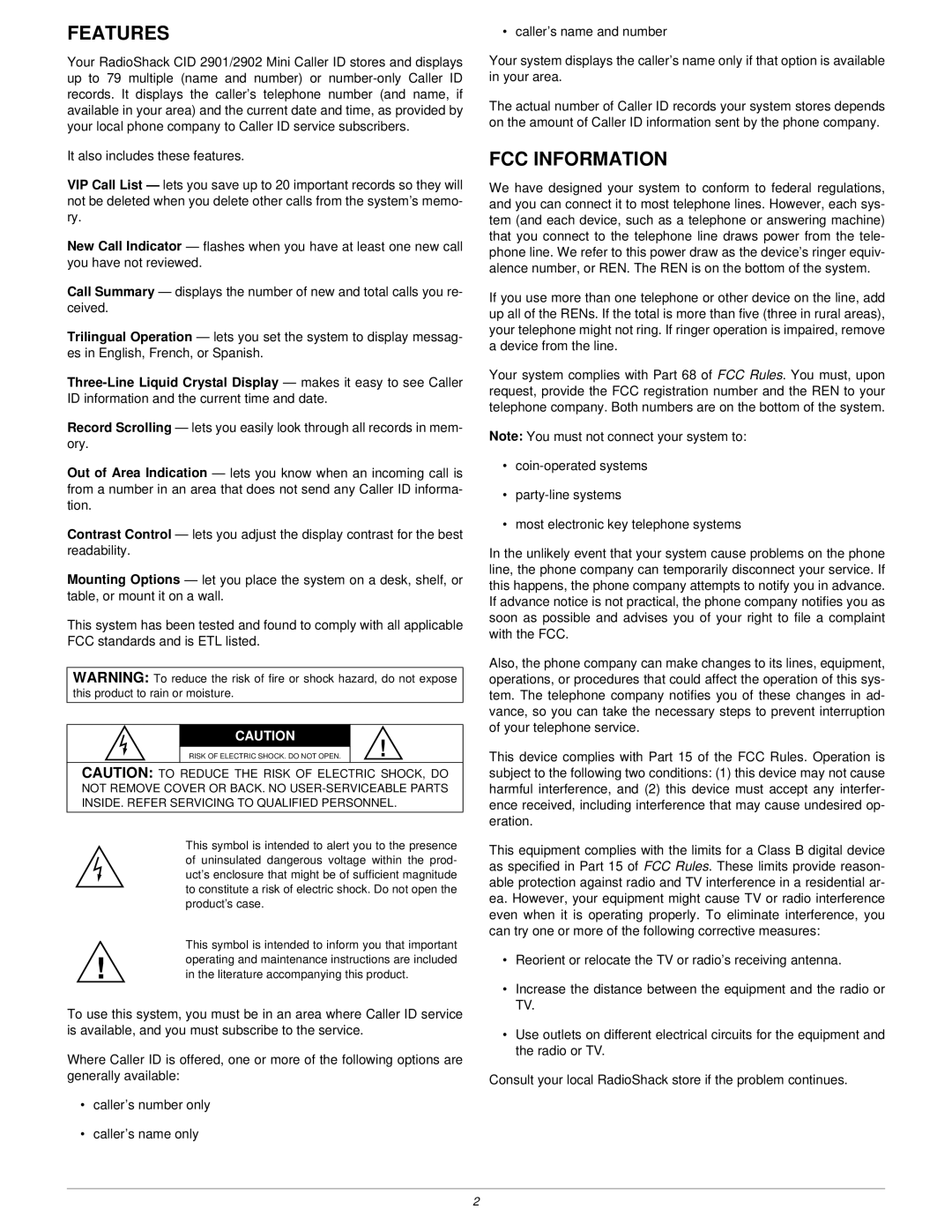
FEATURES
Your RadioShack CID 2901/2902 Mini Caller ID stores and displays up to 79 multiple (name and number) or
It also includes these features.
VIP Call List — lets you save up to 20 important records so they will not be deleted when you delete other calls from the system’s memo- ry.
New Call Indicator — flashes when you have at least one new call you have not reviewed.
Call Summary — displays the number of new and total calls you re- ceived.
Trilingual Operation — lets you set the system to display messag- es in English, French, or Spanish.
Record Scrolling — lets you easily look through all records in mem- ory.
Out of Area Indication — lets you know when an incoming call is from a number in an area that does not send any Caller ID informa- tion.
Contrast Control — lets you adjust the display contrast for the best readability.
Mounting Options — let you place the system on a desk, shelf, or table, or mount it on a wall.
This system has been tested and found to comply with all applicable FCC standards and is ETL listed.
WARNING: To reduce the risk of fire or shock hazard, do not expose this product to rain or moisture.
CAUTION | ! |
RISK OF ELECTRIC SHOCK. DO NOT OPEN. |
CAUTION: TO REDUCE THE RISK OF ELECTRIC SHOCK, DO NOT REMOVE COVER OR BACK. NO
This symbol is intended to alert you to the presence of uninsulated dangerous voltage within the prod- uct’s enclosure that might be of sufficient magnitude to constitute a risk of electric shock. Do not open the product’s case.
This symbol is intended to inform you that important operating and maintenance instructions are included
! in the literature accompanying this product.
To use this system, you must be in an area where Caller ID service is available, and you must subscribe to the service.
Where Caller ID is offered, one or more of the following options are generally available:
•caller’s number only
•caller’s name only
• caller’s name and number
Your system displays the caller’s name only if that option is available in your area.
The actual number of Caller ID records your system stores depends on the amount of Caller ID information sent by the phone company.
FCC INFORMATION
We have designed your system to conform to federal regulations, and you can connect it to most telephone lines. However, each sys- tem (and each device, such as a telephone or answering machine) that you connect to the telephone line draws power from the tele- phone line. We refer to this power draw as the device’s ringer equiv- alence number, or REN. The REN is on the bottom of the system.
If you use more than one telephone or other device on the line, add up all of the RENs. If the total is more than five (three in rural areas), your telephone might not ring. If ringer operation is impaired, remove a device from the line.
Your system complies with Part 68 of FCC Rules. You must, upon request, provide the FCC registration number and the REN to your telephone company. Both numbers are on the bottom of the system.
Note: You must not connect your system to:
•
•
•most electronic key telephone systems
In the unlikely event that your system cause problems on the phone line, the phone company can temporarily disconnect your service. If this happens, the phone company attempts to notify you in advance. If advance notice is not practical, the phone company notifies you as soon as possible and advises you of your right to file a complaint with the FCC.
Also, the phone company can make changes to its lines, equipment, operations, or procedures that could affect the operation of this sys- tem. The telephone company notifies you of these changes in ad- vance, so you can take the necessary steps to prevent interruption of your telephone service.
This device complies with Part 15 of the FCC Rules. Operation is subject to the following two conditions: (1) this device may not cause harmful interference, and (2) this device must accept any interfer- ence received, including interference that may cause undesired op- eration.
This equipment complies with the limits for a Class B digital device as specified in Part 15 of FCC Rules. These limits provide reason- able protection against radio and TV interference in a residential ar- ea. However, your equipment might cause TV or radio interference even when it is operating properly. To eliminate interference, you can try one or more of the following corrective measures:
•Reorient or relocate the TV or radio’s receiving antenna.
•Increase the distance between the equipment and the radio or TV.
•Use outlets on different electrical circuits for the equipment and the radio or TV.
Consult your local RadioShack store if the problem continues.
2
